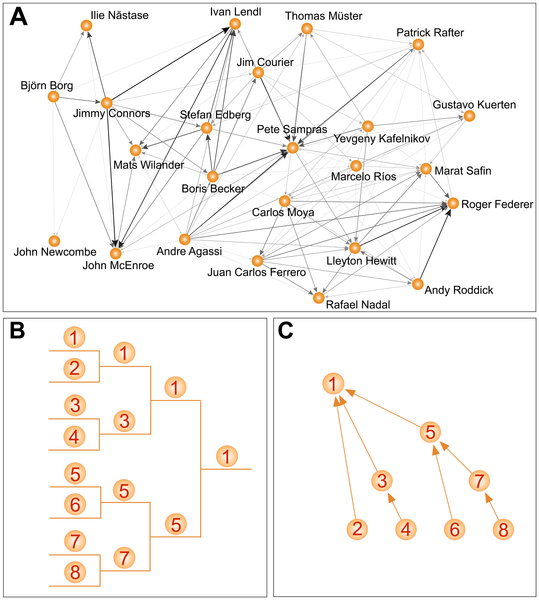Tennis is even more difficult because the actual equipment has changed so much - there is no real way to compare players using a racket of the last 25 years with 50 years ago, no differently than comparing baseball players of today to those of the 'dead ball' era a century ago. But Filippo Radicchi, physicist and postdoctoral fellow in the chemical and biological engineering department of Northwestern's McCormick School of Engineering and Applied Science, has given it a shot. His success is up to you.
He avoids too many generational leaps by starting in 1968, something of a golden era in men's tennis because it had cultural interest in the players and matches lacking today. While fans can tell you who the top players are today, everyone in America knew who John McEnroe and Jimmy Connors were.
Radicchi did a network analysis, similar to the Google PageRank analysis they no longer use because it was flawed and easily manipulated, and input male tennis players who played in at least one Association of Tennis Professionals match between 1968 and 2010. The data was pulled from the Association of Tennis Professionals website. He quantified the importance of players and then ranked them by a rather subjective "tennis prestige" score, determined by playing surface, a player's competitiveness, the quality of his performance and number of victories.
"In this particular ranking system, it's more important to win a single match against a very good player than many matches against not-so-good players," said Radicchi.

Top player network and scheme for a single tournament. In panel a, a subgraph of the contact network restricted only to those players who have been number one in the ATP ranking. Intensities and widths are proportional to the logarithm of the weight carried by each directed edge. In panel b, a schematic view of the matches played during a single tournament, while in panel c the network derived from it.
Here are his top 30 men:
- Jimmy Connors
- Ivan Lendl
- John McEnroe
- Guillermo Vilas
- Andre Agassi
- Stefan Edberg
- Roger Federer
- Pete Sampras
- Ilie Năstase
- Björn Borg
- Boris Becker
- Arthur Ashe
- Brian Gottfried
- Stan Smith
- Manuel Orantes
- Michael Chang
- Roscoe Tanner
- Eddie Dibbs
- Harold Solomon
- Tom Okker
- Mats Wilander
- Goran Ivanišević
- Vitas Gerulaitis
- Rafael Nadal
- Raul Ramirez
- John Newcombe
- Ken Rosewall
- Yevgeny Kafelnikov
- Andy Roddick
- Thomas Muster
Andre Agassi over Roger Federer? And Björn Borg down at 10? MICHAEL CHANG???
"One of the reasons Jimmy Connors ranks on top is because he played for more than 20 years and had the opportunity to win a lot of matches against other very good players," Radicchi said.
He expects current greats Roger Federer and Rafael Nadal to eventually move up in the rankings if they face tough competition and continue to win matches. Radicchi says he will run this study again in 10 years to see how the rankings change. He won't be programming for EA Sports using this method, though. Why only use Grand Slams and ATP World Tour tournaments? It's a computer so running more 3,640 tournaments and 133,261 matches would be trivial.
He believes this gives a glimpse at the power of complex network analysis.
"The same application could be used to rank countries involved in the global trade of certain commodities," Radicchi said. "In general, this type of analysis can help scientists better explain and understand complicated global relationships."
Well, not if they weigh 'number of victories' so heavily because that is just a measure of time. Hosni Mubarak and Muammar Quadaffi would do quite well in rankings of complicated global relationships using a few variables and running a Monte Carlo analysis. In his results from the 1980s Björn Borg does not even rank anywhere despite playing (and playing well - just not often) until 1993.
Citation: Radicchi F (2011) Who Is the Best Player Ever? A Complex Network Analysis of the History of Professional Tennis. PLoS ONE 6(2): e17249. doi:10.1371/journal.pone.0017249






Comments